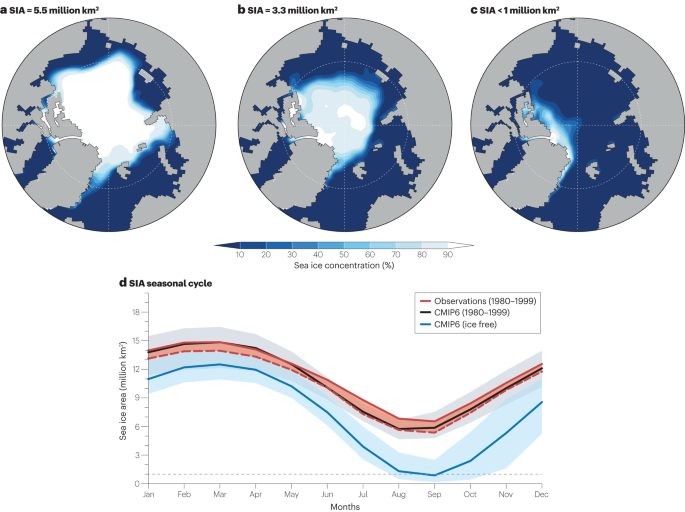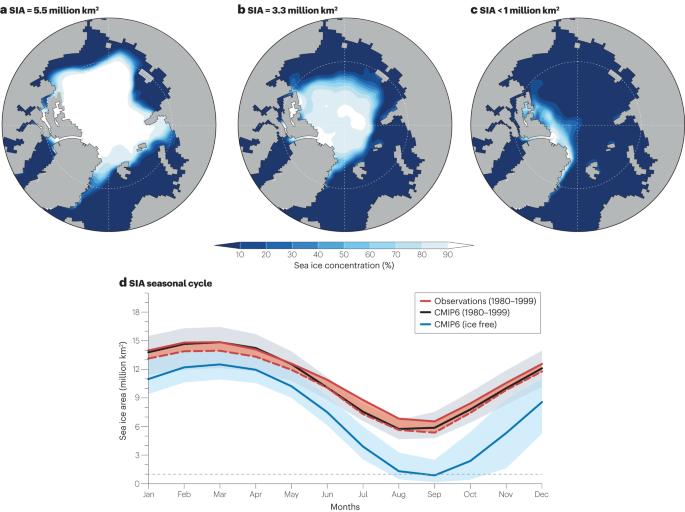Projections of an ice-free Arctic Ocean
引用次数: 0
Abstract
Observed Arctic sea ice losses are a sentinel of anthropogenic climate change. These reductions are projected to continue with ongoing warming, ultimately leading to an ice-free Arctic (sea ice area <1 million km2). In this Review, we synthesize understanding of the timing and regional variability of such an ice-free Arctic. In the September monthly mean, the earliest ice-free conditions (the first single occurrence of an ice-free Arctic) could occur in 2020–2030s under all emission trajectories and are likely to occur by 2050. However, daily September ice-free conditions are expected approximately 4 years earlier on average, with the possibility of preceding monthly metrics by 10 years. Consistently ice-free September conditions (frequent occurrences of an ice-free Arctic) are anticipated by mid-century (by 2035–2067), with emission trajectories determining how often and for how long the Arctic could be ice free. Specifically, there is potential for ice-free conditions in May–January and August–October by 2100 under a high-emission and low-emission scenario, respectively. In all cases, sea ice losses begin in the European Arctic, proceed to the Pacific Arctic and end in the Central Arctic, if becoming ice free at all. Future research must assess the impact of model selection and recalibration on projections, and assess the drivers of internal variability that can cause early ice-free conditions. With continued anthropogenic warming, an ice-free Arctic (sea ice area <1 million km2) is inevitable. This Review outlines the various characteristics of an ice-free Arctic, highlighting that future emission trajectories will determine where, how frequently and how long the Arctic will be ice free each year.


北冰洋无冰预测
观测到的北极海冰减少是人为气候变化的前兆。随着气候不断变暖,预计海冰将继续减少,最终导致北极无冰(海冰面积达 100 万平方公里)。在这篇综述中,我们总结了对北极无冰的时间和区域变化的理解。在九月的月平均值中,在所有排放轨迹下,最早的无冰条件(北极首次出现无冰)可能出现在 2020-2030 年代,并有可能出现在 2050 年。然而,9 月的每日无冰状况预计平均会提前约 4 年,有可能比月度指标提前 10 年。预计到本世纪中期(2035-2067 年),9 月将出现持续无冰条件(北极无冰的频繁出现),排放轨迹决定了北极无冰的频率和时间。具体来说,在高排放和低排放情景下,到 2100 年,分别有可能在 5 月至 1 月和 8 月至 10 月出现无冰状态。在所有情况下,海冰损失都是从欧洲北极开始,然后到太平洋北极,最后在北极中部结束,甚至完全变成无冰状态。未来的研究必须评估模型选择和重新校准对预测的影响,并评估可能导致早期无冰状况的内部变异驱动因素。
本文章由计算机程序翻译,如有差异,请以英文原文为准。
求助全文
约1分钟内获得全文
求助全文

 求助内容:
求助内容: 应助结果提醒方式:
应助结果提醒方式:


